low beam TOYOTA LAND CRUISER 2021 Owners Manual (in English)
[x] Cancel search | Manufacturer: TOYOTA, Model Year: 2021, Model line: LAND CRUISER, Model: TOYOTA LAND CRUISER 2021Pages: 632, PDF Size: 13.87 MB
Page 94 of 632
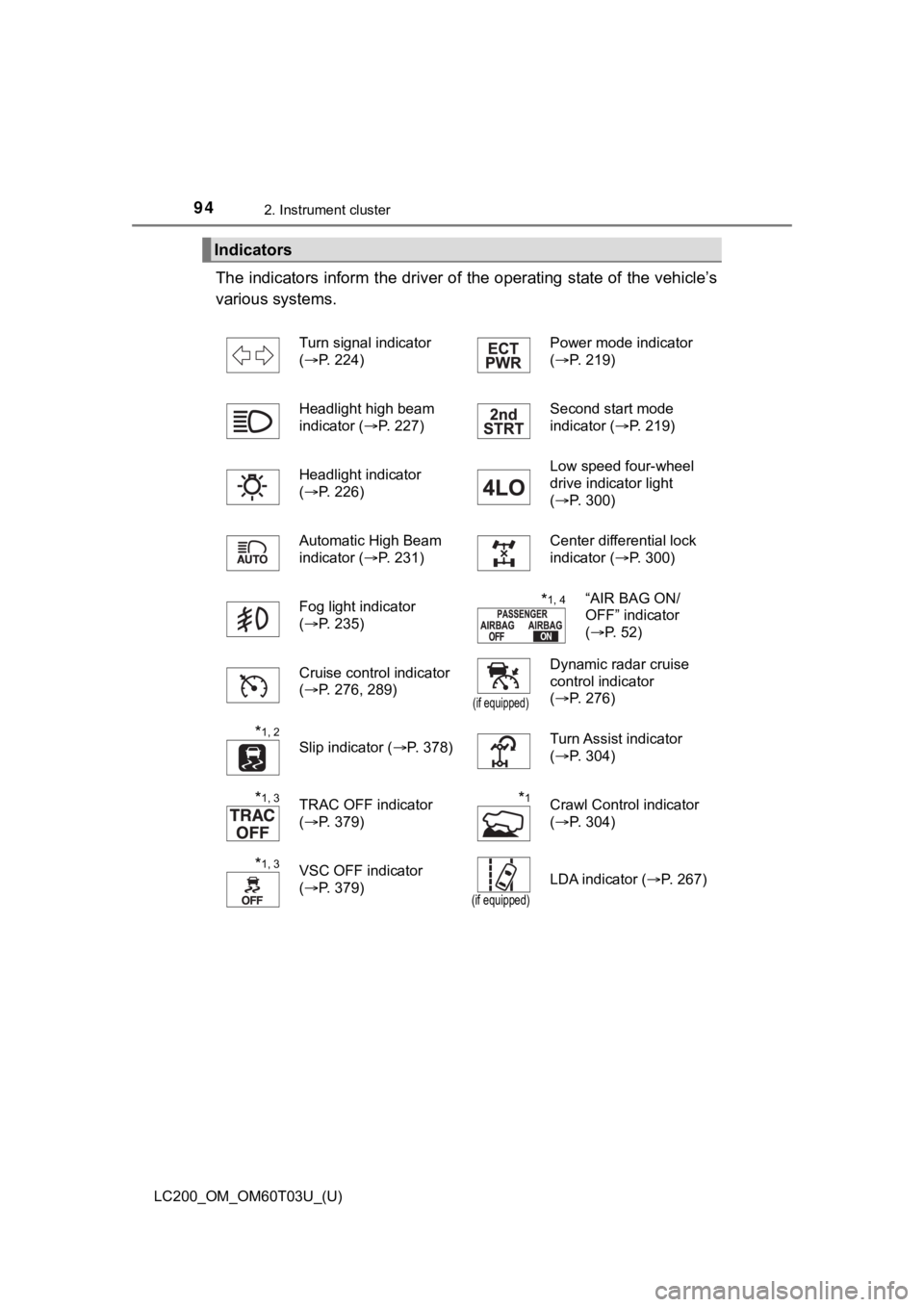
94
LC200_OM_OM60T03U_(U)
2. Instrument cluster
The indicators inform the driver of the operating state of the vehicle’s
various systems.
Indicators
Turn signal indicator
( P. 224) Power mode indicator
(
P. 219)
Headlight high beam
indicator ( P. 227) Second start mode
indicator (
P. 219)
Headlight indicator
( P. 226) Low speed four-wheel
drive indicator light
(
P. 300)
Automatic High Beam
indicator ( P. 231) Center differential lock
indicator (
P. 300)
Fog light indicator
( P. 235)
*1, 4“AIR BAG ON/
OFF” indicator
(P. 52)
Cruise control indicator
( P. 276, 289)
(if equipped)
Dynamic radar cruise
control indicator
(P. 276)
*1, 2
Slip indicator ( P. 378)Turn Assist indicator
(P. 304)
*1, 3TRAC OFF indicator
(P. 379)*1Crawl Control indicator
(P. 304)
*1, 3VSC OFF indicator
(P. 379)
(if equipped)
LDA indicator ( P. 267)
Page 230 of 632
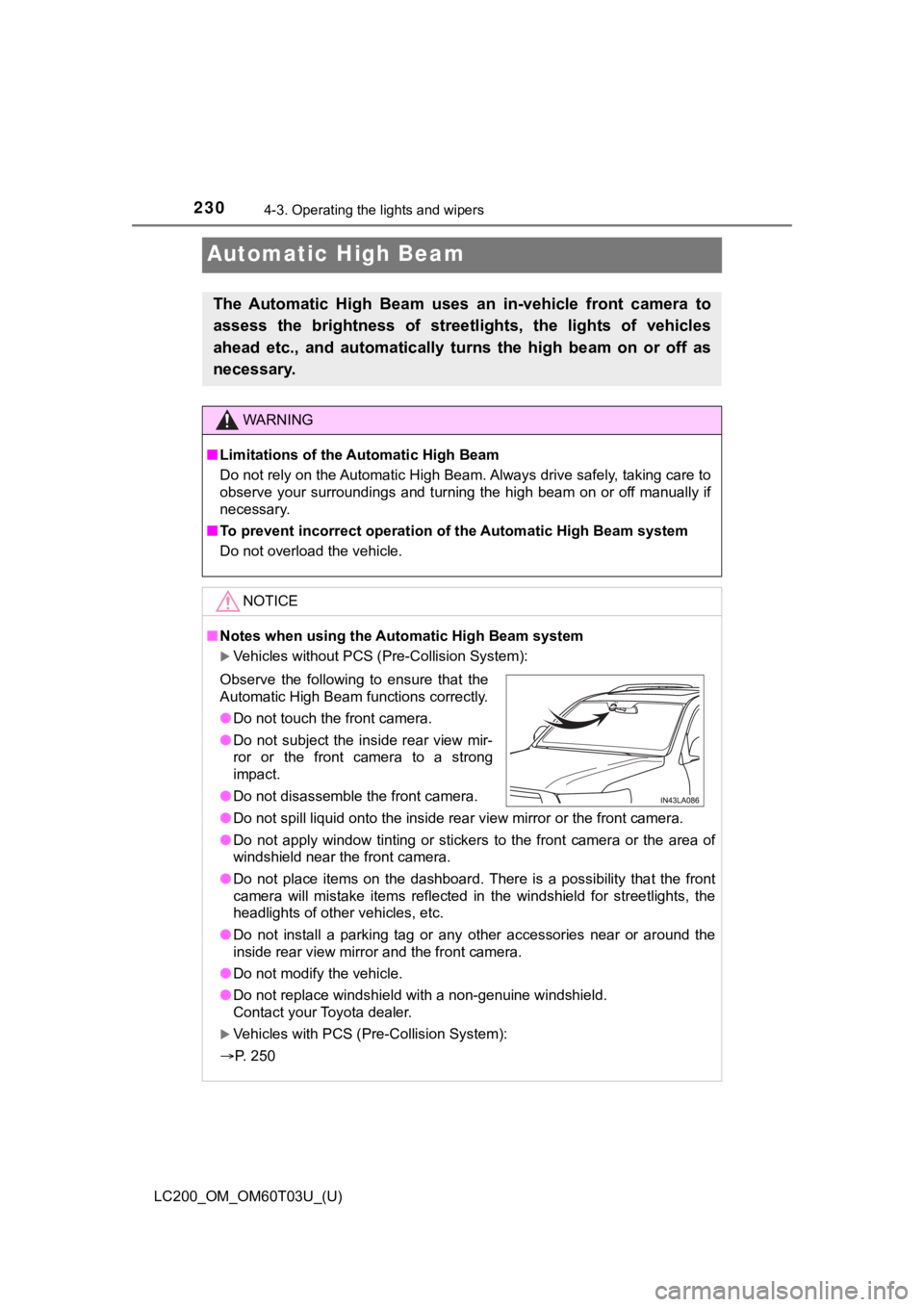
230
LC200_OM_OM60T03U_(U)
4-3. Operating the lights and wipers
Automatic High Beam
The Automatic High Beam uses an in-vehicle front camera to
assess the brightness of streetl ights, the lights of vehicles
ahead etc., and automatically turns the high beam on or off as
necessary.
WARNING
■ Limitations of the Automatic High Beam
Do not rely on the Automatic High Beam. Always drive safely, ta king care to
observe your surroundings and turning the high beam on or off m anually if
necessary.
■ To prevent incorrect operation o f the Automatic High Beam syste m
Do not overload the vehicle.
NOTICE
■ Notes when using the Aut omatic High Beam system
Vehicles without PCS (Pre-Collision System):
● Do not spill liquid onto the inside rear view mirror or the fro nt camera.
● Do not apply window tinting or stickers to the front camera or the area of
windshield near the front camera.
● Do not place items on the dashboard. There is a possibility tha t the front
camera will mistake items reflected in the windshield for stree tlights, the
headlights of other vehicles, etc.
● Do not install a parking tag or any other accessories near or a round the
inside rear view mirror and the front camera.
● Do not modify the vehicle.
● Do not replace windshield with a non-genuine windshield.
Contact your Toyota dealer.
Vehicles with PCS (Pre-Collision System):
P. 250
Observe the following to ensure that the
Automatic High Beam functions correctly.
●Do not touch the front camera.
● Do not subject the inside rear view mir-
ror or the front camera to a strong
impact.
● Do not disassemble the front camera.
Page 231 of 632
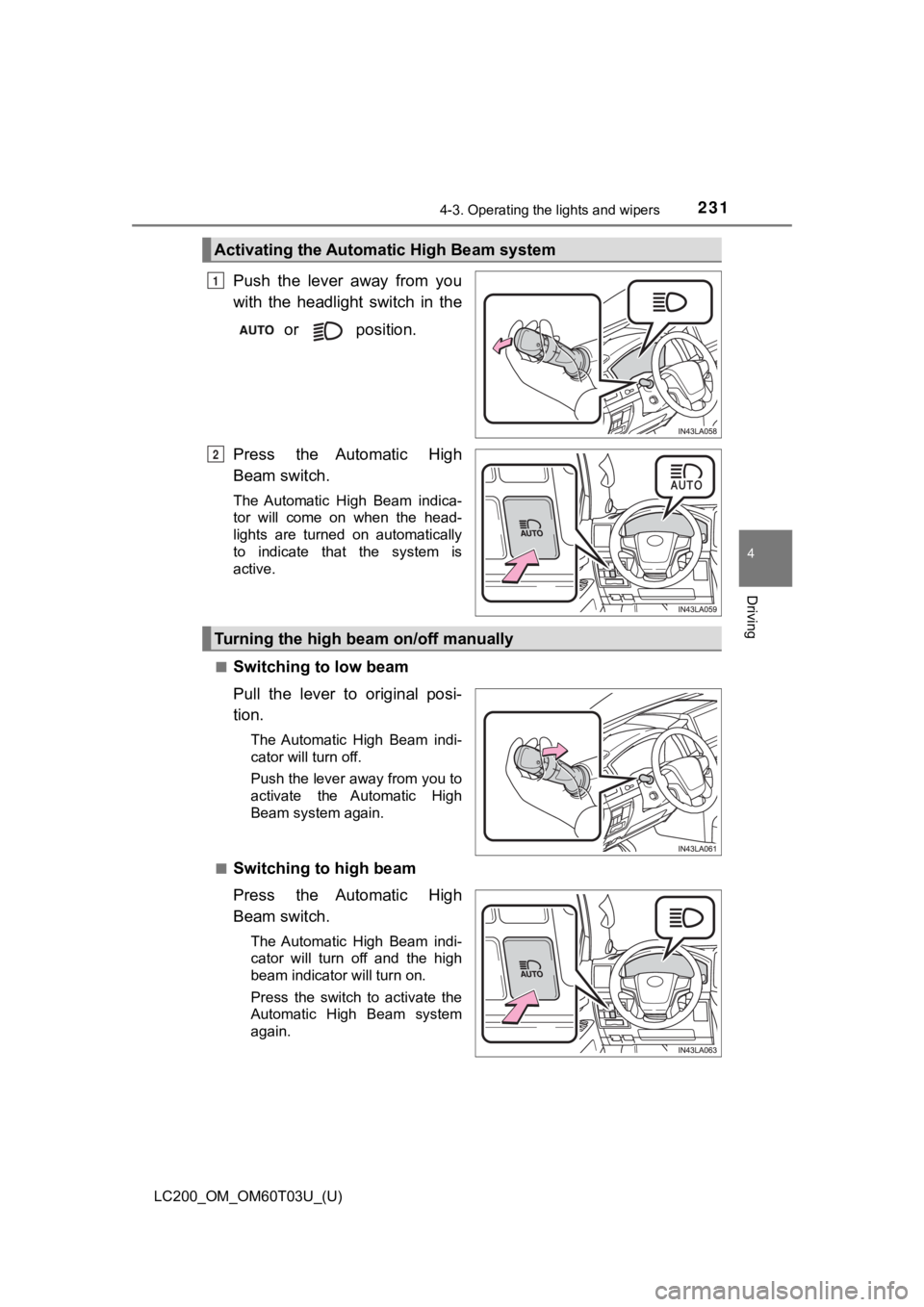
LC200_OM_OM60T03U_(U)
2314-3. Operating the lights and wipers
4
Driving
Push the lever away from you
with the headlight switch in the or position.
Press the Automatic High
Beam switch.
The Automatic High Beam indica-
tor will come on when the head-
lights are turned on automatically
to indicate that the system is
active.
■
Switching to low beam
Pull the lever to original posi-
tion.
The Automatic High Beam indi-
cator will turn off.
Push the lever away from you to
activate the Automatic High
Beam system again.
■
Switching to high beam
Press the Automatic High
Beam switch.
The Automatic High Beam indi-
cator will turn off and the high
beam indicator will turn on.
Press the switch to activate the
Automatic High Beam system
again.
Activating the Automatic High Beam system
1
2
Turning the high beam on/off manually
Page 232 of 632

232
LC200_OM_OM60T03U_(U)
4-3. Operating the lights and wipers
■High beam automatic turning on or off conditions
●When all of the following conditions are fulfilled, the high be am will be auto-
matically turned on (after approximately 1 second):
• Vehicle speed is above approximately 21 mph (34 km/h).
• The area ahead of the vehicle is dark.
• There are no vehicles ahead with headlights or tail lights turned on.
• There are few streetlights on the road ahead.
● If any of the following conditions are fulfilled, the high beam will be automat-
ically turned off:
• Vehicle speed drops below approximately 17 mph (27 km/h).
• The area ahead of the vehicle is not dark.
• Vehicles ahead have headlights or tail lights turned on.
• There are many streetlights on the road ahead.
■ Front camera detection information
●The high beam may not be automatically turned off in the following situa-
tions:
• When oncoming vehicles suddenly appear from a curve
• When the vehicle is cut in front of by another vehicle
• When vehicles ahead are hidden from sight due to repeated curv es, road
dividers or roadside trees
• When vehicles ahead appear from the faraway lane on wide road
• When vehicles ahead have no lights
● The high beam may be turned off if a vehicle ahead that is usin g fog lights
without using the headlights is detected.
● Houselights, streetlights, traffic signals, and illuminated billboards or signs
may cause the high beam to switch to the low beams, or the low beams to
remain on.
● The following factors may affect the amount of time taken to tu rn the high
beam on or off:
• The brightness of headlights, fog lights, and tail lights of v ehicles ahead
• The movement and direction of vehicles ahead
• When a vehicle ahead only has operational lights on one side
• When a vehicle ahead is a two-wheeled vehicle
• The condition of the road (gradient, curve, condition of the r oad surface
etc.)
• The number of passengers and amount of baggage
● The high beam may be turned on or off when the driver does not expect it.
● Bicycles or similar objects may not be detected.
Page 233 of 632

LC200_OM_OM60T03U_(U)
2334-3. Operating the lights and wipers
4
Driving
●In the situations shown below, the system may not be able to accurately
detect surrounding brightness levels. This may cause the low be ams to
remain on or the high beams to cause problems for pedestrians, vehicles
ahead or other parties. In these cases, manually switch between the high
and low beams.
• In bad weather (rain, snow, fog, sandstorms etc.)
• The windshield is obscured by fog, mist, ice, dirt etc.
• The windshield is cracked or damaged.
• The inside rear view mirror or front camera is deformed or dir ty.
• The front camera temperature is extremely high.
• Surrounding brightness levels are equal to those of headlights , tail lights
or fog lights.
• Vehicles ahead have headlights that are either switched off, d irty, are
changing color, or are not aimed properly.
• When driving through an area of intermittently changing brightness and darkness
• When frequently and repeatedly driving ascending/descending roads, or roads with rough, bumpy or uneven surfaces (such as stone-paved
roads, gravel tracks etc.)
• When frequently and repeatedly taking curves or driving on a w inding
road
• There is a highly reflective object ahead of the vehicle, such as a sign or
a mirror.
• The back of a vehicle ahead is highly reflective, such as a co ntainer on a
truck.
• The vehicle’s headlights are damaged or dirty, or are not aime d properly.
• The vehicle is listing or tilting, due to a flat tire, a trailer being towed etc.
• The high beam and low beam are repeatedly being switched betwe en in
an abnormal manner.
• The driver believes that the high beam may be causing problems or dis-
tress to other drivers or pedestrians nearby.
■ If a warning message of the Aut omatic High Beam is displayed...
It may indicate a malfunction in the system. Contact your Toyota dealer.
Page 234 of 632

234
LC200_OM_OM60T03U_(U)
4-3. Operating the lights and wipers
■Temporary lowering sensor sensitivity
The sensitivity of the sensor can be temporarily lowered.
Vehicles without PCS (Pre-Collision System):
To lower the sensitivity, push and hold on the inside rear view mirror for
15 to 20 seconds, and release. The indicator light on the insid e rear view mir-
ror will flash to indicate that the sensitivity has been lowere d.
When the engine switch is turned off, the sensitivity will be r eturned to its nor-
mal level.
Vehicles with PCS (Pre-Collision System):
Turn the engine switch off while the following conditions are met.
• The headlight switch is in .
• The headlight switch lever is in low beam position. Turn the engine switch to IGNITION ON mode.
Within 30 seconds after , repeat pushing the headlight switch l ever to
the high beam position then pulling it to the low beam position quickly 10
times, then leave the lever in high beam position.
Automatic High Beam (headlights) may turn on even the vehicle i s stopped.
1
2
32
Page 235 of 632
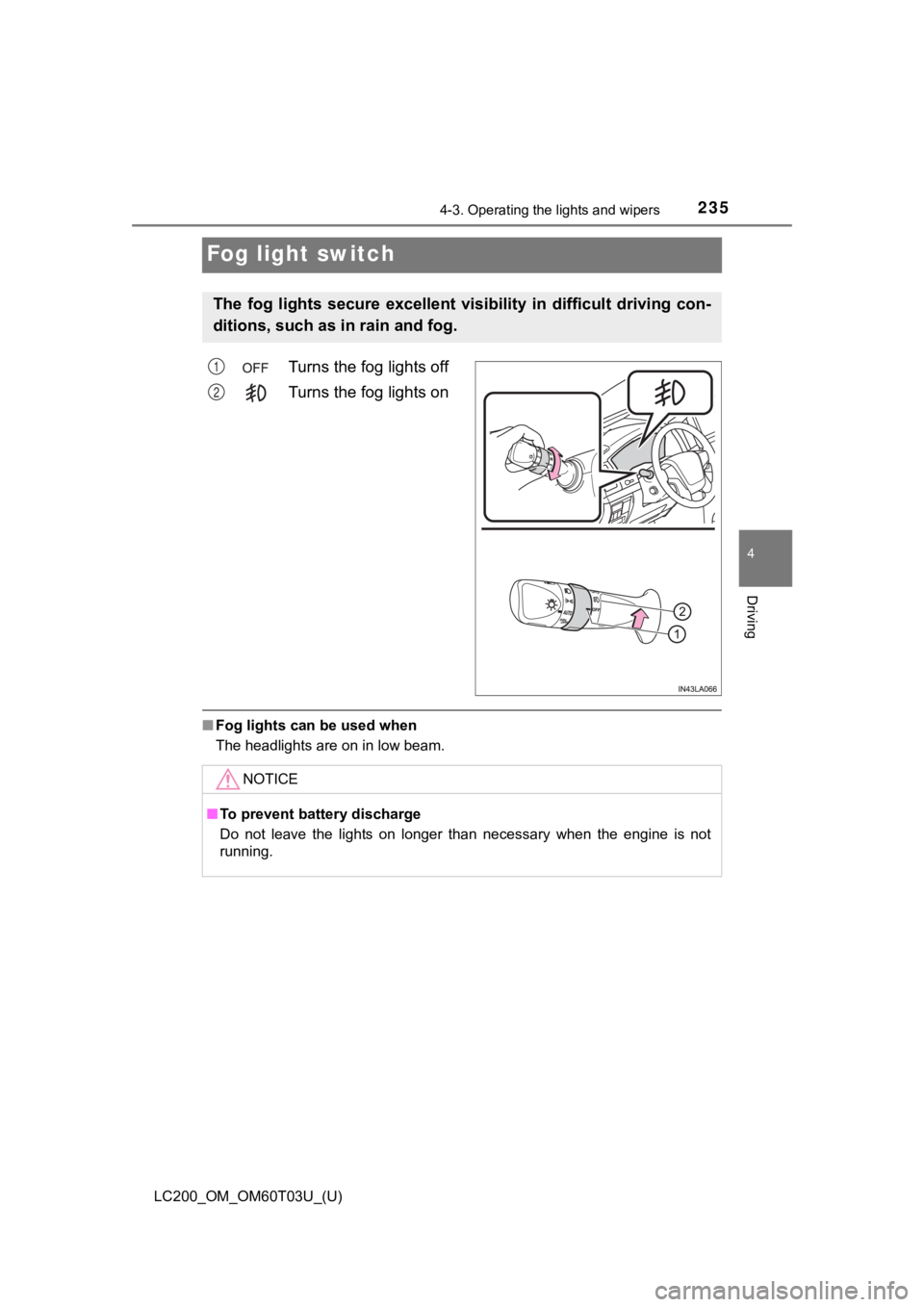
235
LC200_OM_OM60T03U_(U)
4-3. Operating the lights and wipers
4
Driving
Fog light switch
Turns the fog lights off
Turns the fog lights on
■Fog lights can be used when
The headlights are on in low beam.
The fog lights secure excellent visibility in difficult driving con-
ditions, such as in rain and fog.
1
2
NOTICE
■To prevent battery discharge
Do not leave the lights on longer than necessary when the engin e is not
running.
Page 247 of 632
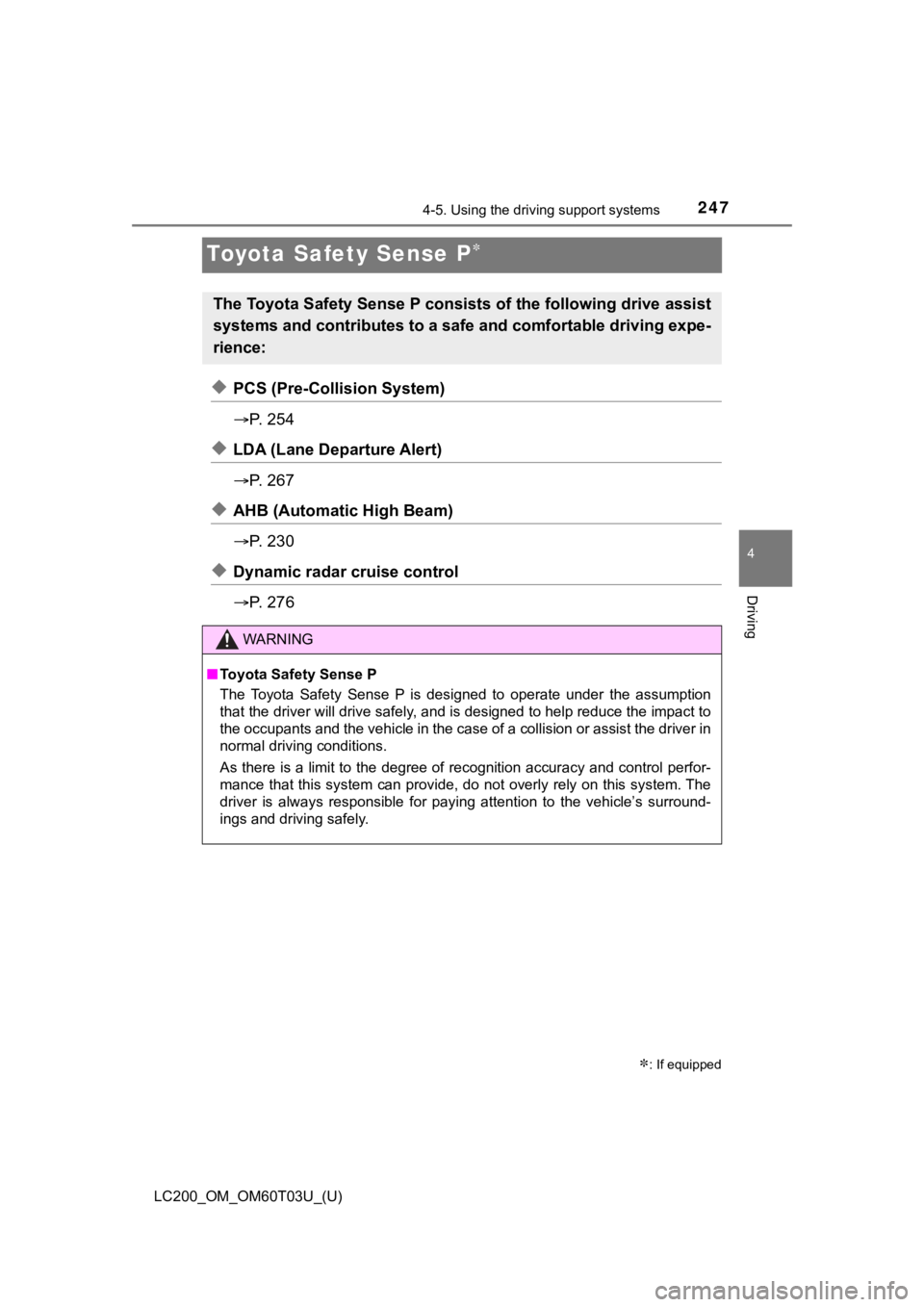
247
LC200_OM_OM60T03U_(U)
4-5. Using the driving support systems
4
Driving
Toyota Safety Sense P
◆PCS (Pre-Collision System)
P. 2 5 4
◆LDA (Lane Departure Alert)
P. 2 6 7
◆AHB (Automatic High Beam)
P. 2 3 0
◆Dynamic radar cruise control
P. 2 7 6
: If equipped
The Toyota Safety Sense P consists of the following drive assis t
systems and contributes to a safe and comfortable driving expe-
rience:
WARNING
■ Toyota Safety Sense P
The Toyota Safety Sense P is designed to operate under the assu mption
that the driver will drive safely, and is designed to help redu ce the impact to
the occupants and the vehicle in the case of a collision or ass ist the driver in
normal driving conditions.
As there is a limit to the degree of recognition accuracy and control perfor-
mance that this system can provide, do not overly rely on this system. The
driver is always responsible for paying attention to the vehicl e’s surround-
ings and driving safely.
Page 273 of 632

LC200_OM_OM60T03U_(U)
2734-5. Using the driving support systems
4
Driving
■Conditions in which functions may not operate properly
In the following situations, the front camera may not detect wh ite (yellow)
lines and various functions may not operate normally.
● There are shadows on the road that run parallel with, or cover, the white
(yellow) lines.
● The vehicle is driven in an area without white (yellow) lines, such as in front
of a tollgate or checkpoint, or at an intersection, etc.
● The white (yellow) lines are cracked, “Botts’ dots”, “Raised pa vement
marker” or stones are present.
● The white (yellow) lines cannot be seen or are difficult to see due to sand,
etc.
● The vehicle is driven on a road surface that is wet due to rain , puddles, etc.
● The traffic lines are yellow (which may be more difficult to re cognize than
lines that are white).
● The white (yellow) lines cross over a curb, etc.
● The vehicle is driven on a bright surface, such as concrete.
● The vehicle is driven on a surface that is bright due to reflec ted light, etc.
● The vehicle is driven in an area where the brightness changes s uddenly,
such as at the entrances and exits of tunnels, etc.
● Light from the headlights of an oncoming vehicle, the sun, etc. enters the
camera.
● The vehicle is driven where the road diverges, merges, etc.
● The vehicle is driven on a slope.
● The vehicle is driven on a road which tilts left or right, or a winding road.
● The vehicle is driven on an unpaved or rough road.
● The vehicle is driven around a sharp curve.
● The traffic lane is excessively narrow or wide.
● The vehicle is extremely tilted due to carrying heavy luggage or having
improper tire pressure.
● The distance to the preceding vehicle is extremely short.
● The vehicle is moving up and down a large amount due to road co nditions
during driving (poor roads or road seams).
● The headlight lenses are dirty and emit a faint amount of light at night, or the
beam axis has deviated.
● The vehicle has just changed lanes or crossed an intersection.
Page 541 of 632

5417-2. Steps to take in an emergency
LC200_OM_OM60T03U_(U)
7
When trouble arises
■System warning lights
The master warning light does not come on or flash in the follo wing case.
Instead, a separate system warning light will come on along wit h a message
or image shown on the multi-information display.
● Indicates that the PCS (Pre-Collision System) is not currently functional
The PCS warning light flashes or illuminates. ( P. 531)
● Indicates that a door is not fully closed while the vehicle is stopped.
The Open door warning light comes on. ( P. 532)
■ If “See Owner’s Manual” is shown
●If “Smart key System Malfunction” is shown, this may be a malfunction.
Immediately have the vehicle inspected by your Toyota dealer.
● If “Transmission Fluid Temp High” is shown, it indicates that t he automatic
transmission fluid temperature is too high.
Immediately stop the vehicle in a safe place, shift the shift lever to P and
wait until the warning message and light go off. If the warning message and
light go off, you may start the vehicle again. If the warning m essage and
light do not go off, contact your Toyota dealer.
■ If “Shift to P Before Exiting Vehicle” is shown
Message is displayed when the driver’s door is opened without t urning the
engine switch to off with the shift lever in any position other than P.
Shift the shift lever to P.
■ If “Power Turned Off to Save Battery” is shown
Power was turned off due to the automatic power off function.
Next time when starting the engine, increase the engine speed s lightly and
maintain that level for approximately 5 minutes to recharge the battery.
■ When a message that indicates the need for the shift lever oper ation is
shown
To prevent the shift lever from being operated incorrectly or t he vehicle from
moving unexpectedly, a message that requires shifting the shift lever may be
shown on the multi-information display. In that case, follow th e instruction of
the message and shift the shift lever.
■ When “Headlight System Malfuncti on Visit Your Dealer” is displayed on
the multi-information display
The following systems may be malfunctioning. Have the vehicle inspected by
your Toyota dealer.
● The LED headlight system
● The automatic headlight leveling system
● Automatic High Beam (if equipped)